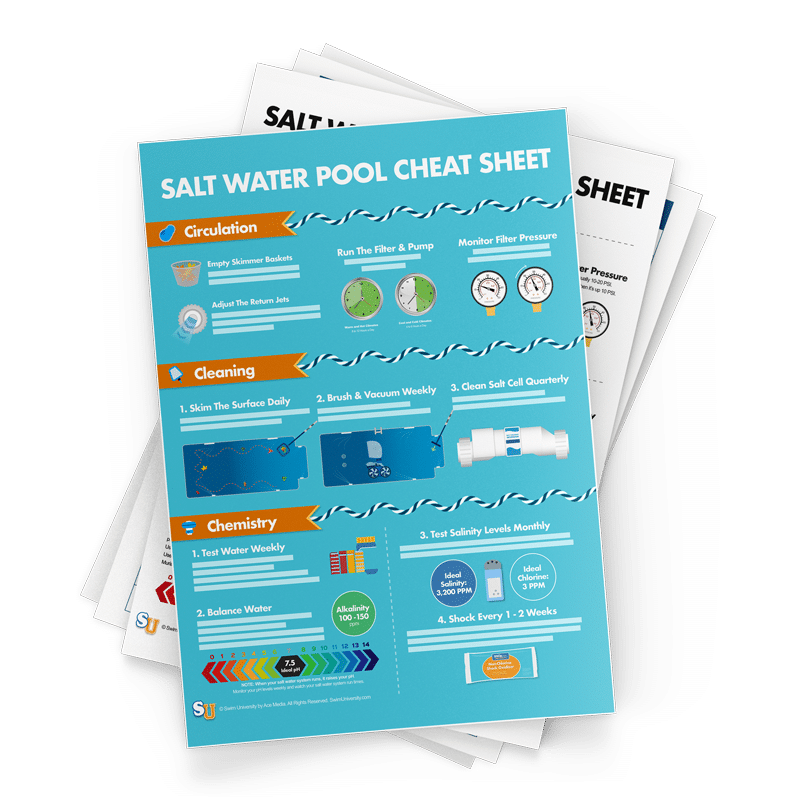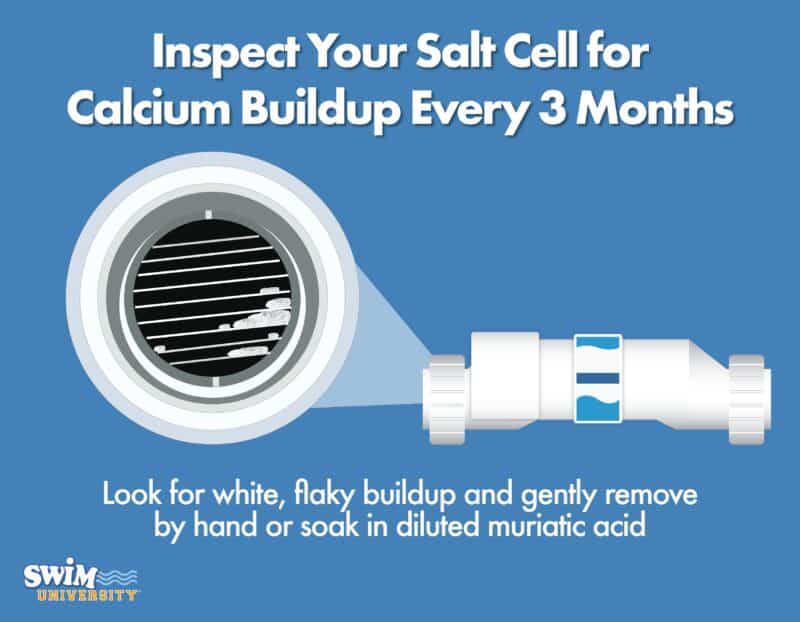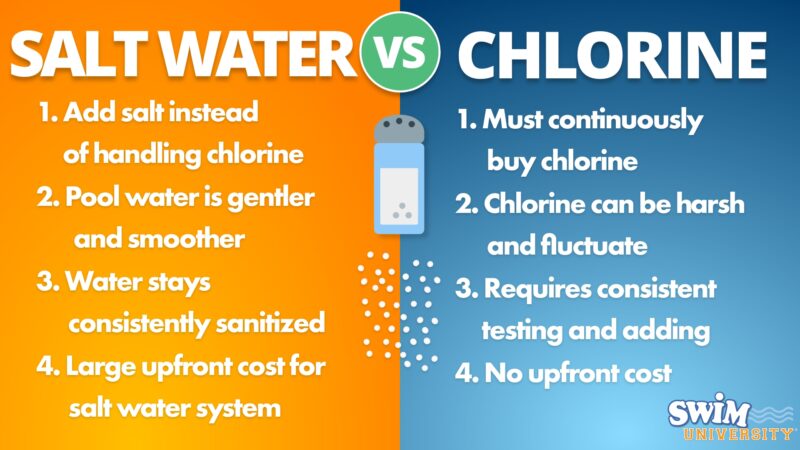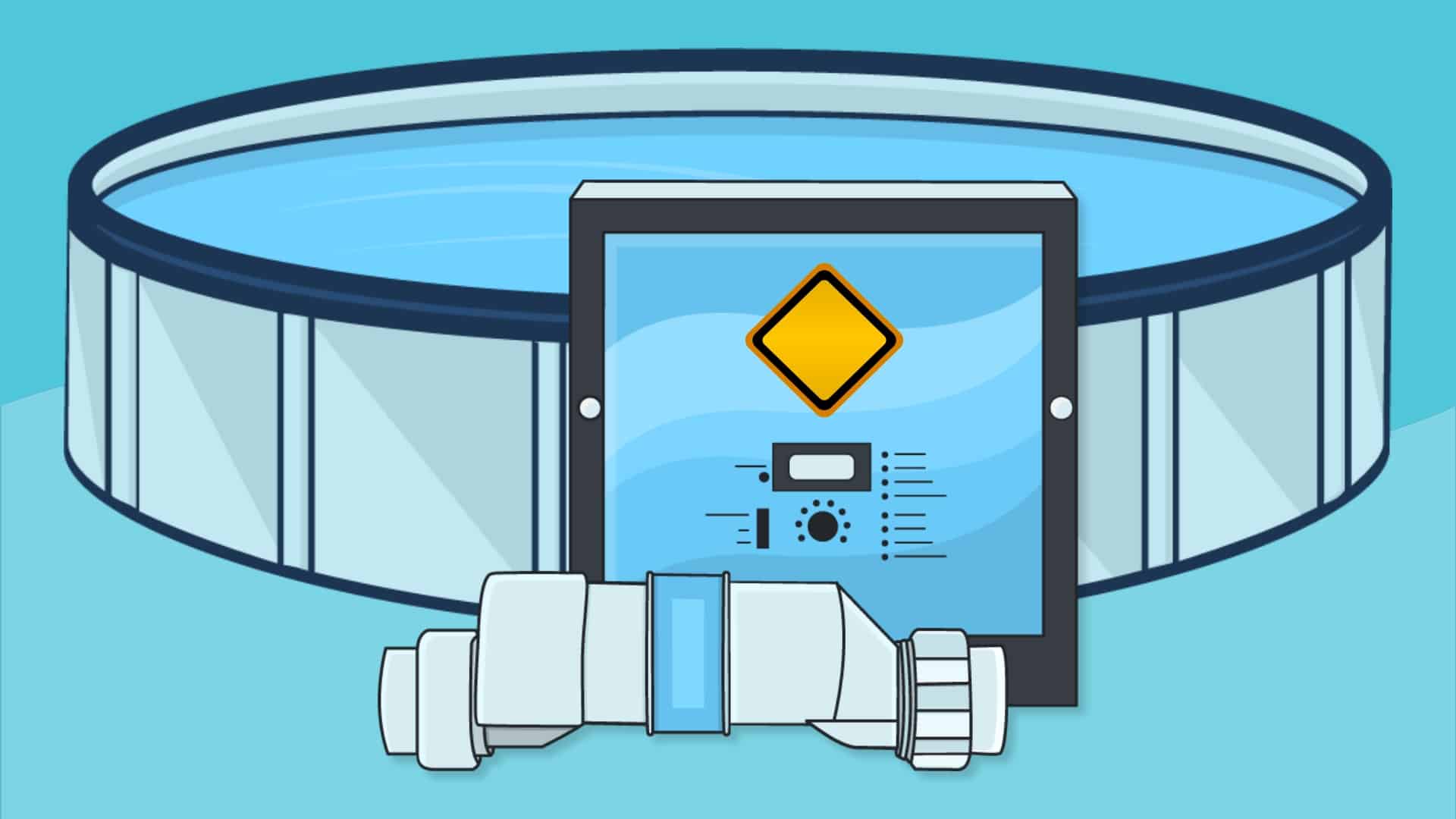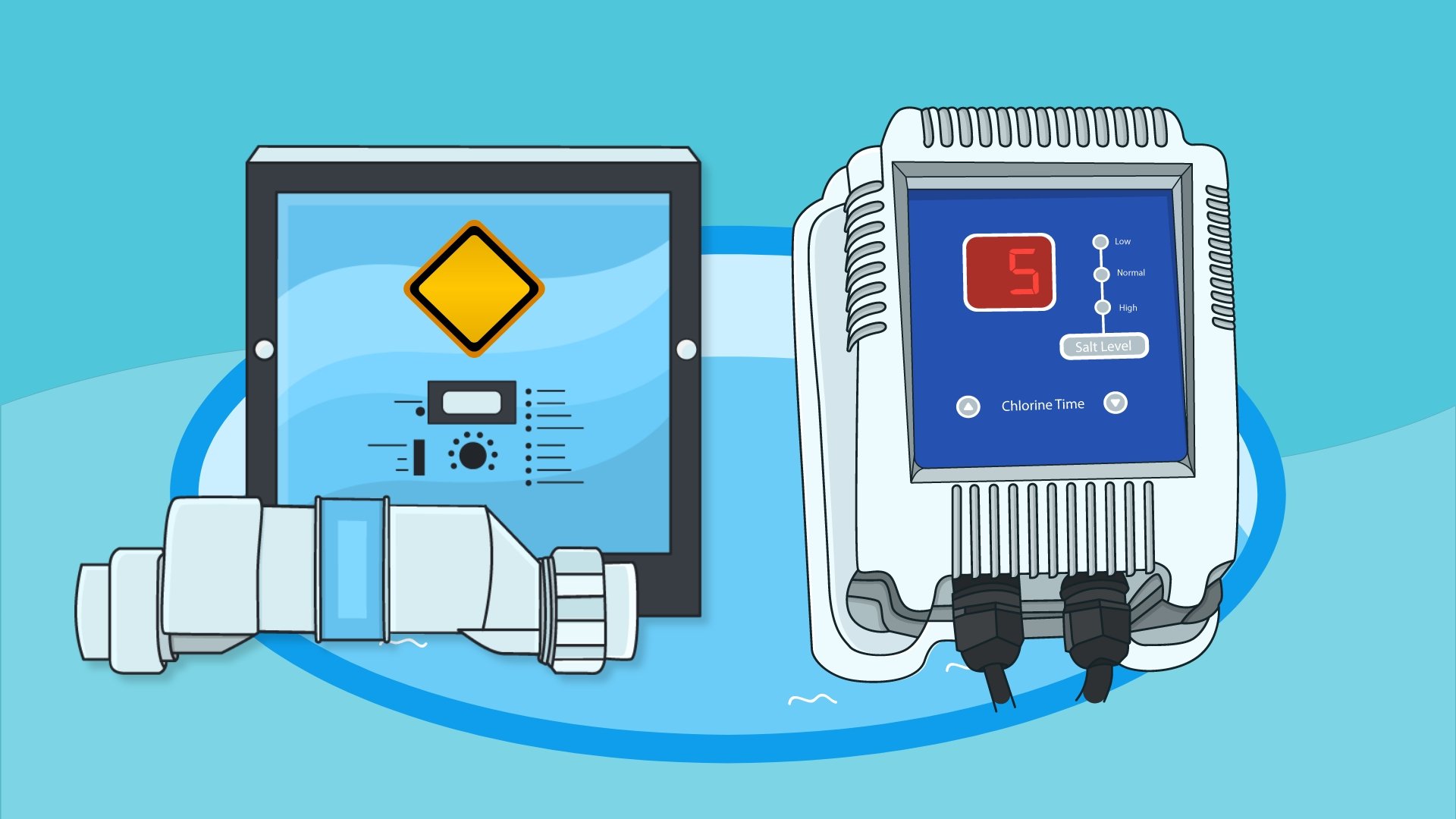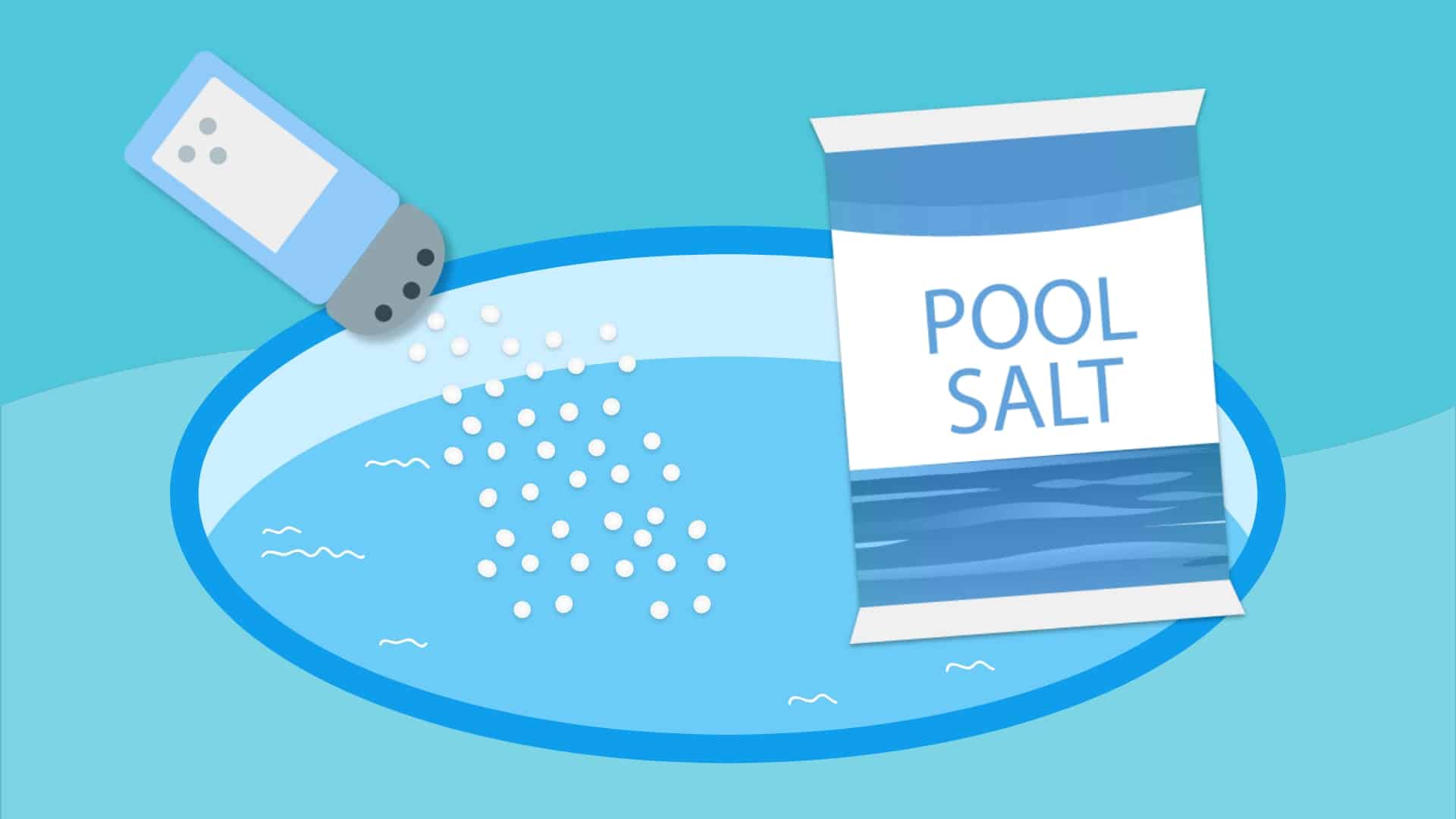Salt Water Pool Maintenance 101: How to Keep it Clean and Clear
There are a few key differences between salt water pool maintenance and traditional chlorine pool maintenance. While you still need to keep your water balanced and circulating properly like a normal pool, you’ll need to pay extra to things like high pH levels and calcium build-up in your saltwater generator.
There are 7 key components to salt water pool maintenance:
- Add the Right Amount of Salt
- Maintain Proper Water Circulation
- Prevent Erosion and Calcium Buildup
- Check Your Salt Cell Every 3 Months
- Keep Your Water Balanced, Especially pH and Chlorine
- Shock Your Pool Every Week
- Skim, Brush, and Vacuum Every Week
Check out our video below or keep reading for a complete walkthrough.
Before we cover each component of salt water pool maintenance, remember that a salt water pool is a chlorine pool. Your salt water generator, also known as a salt chlorine generator, turns the salt that’s added to your pool into chlorine. So instead of adding chlorine directly to your water to keep your chlorine levels up, you add salt to your water that produces chlorine. Check out our guide on Salt Water vs. Chlorine Pools for more information.
By the way, if you want all of this pool care information in one easy-to-use place, grab our FREE Pool Care Cheat Sheet!
1. Add the Right Amount of Salt to Your Pool
Usually, you only need to add salt to your pool water once or twice a year or right when opening your pool. That’s because the salt you add to the water won’t dissipate. The salt water generator uses the salt to produce chlorine and then it’s recycled back into the water. So you’ll likely only need to add salt right after pool opening, heavy rain, or when adding fresh water since this will dilute your salinity.
Use pool-grade salt (sodium chloride) that’s at least 99% pure. Certain chlorine generators need to be turned off while you’re adding salt to the pool, so check your owner’s manual first. And be sure to turn the pool pump on to help circulate the salt through the water.
How Much Salt to Add to Your Pool
You’ll need to add enough salt to get your salinity level between 2,700 to 3,400 parts per million (PPM). Usually, 3,200 PPM is ideal but check your owner’s manual for their specific, recommended range. Then use a pool salinity calculator to find out how much salt you need.
If you have a 20,000-gallon pool and you’re adding salt for the first time, you’ll need about 568 pounds of salt. Pool salt is sold in 40-pound bags, so you’d need about 14 bags of salt.
Remember, it’s always easier to add more salt later than remove it once it’s added. So if you’re unsure, add less salt initially and retest your salinity levels before adding more.
How to Add Salt to Pool
First, turn on your pool filter system. Then pour the salt directly into the deep end of your pool. Use a pool brush to push the salt around the bottom of the pool. Pushing the salt will also help it dissolve in the water. Then allow your pump and filter to run for 24 hours to ensure even distribution of salt through the pool.
Test the water’s salinity with a digital salinity tester or salt test strips. Continue to add salt if the levels are still low. But if the salt level is too high (5,000 ppm or higher), you’ll need to dilute your pool water to bring salinity down.
Once the salt level is where it should be, turn on the salt chlorine generator.
2. Maintain Proper Water Circulation
If your swimming pool water isn’t circulating well, your salt water concentration may get too high in some areas.
Double-check your salt levels around your pool with a digital salinity tester. Be sure to test the water in multiple areas to make sure the numbers are consistent. If there’s a drastic difference between numbers, angle your return jets towards the pockets of salinity to help circulate dead zones.
Keep your water circulating by running your pump and filter at least 8 hours a day. For more help with pool pump run times, check out our guide on How Long Should I Run My Pool Pump Every Day?
3. Prevent Erosion and Calcium Buildup
Splash out can cause high concentrations of salt outside of your pool. And that can erode parts of your pool, especially limestone or other soft stone coping around your pool. So be sure to hose down the area around your pool. Splash out can also lead to high concentrations of salt on the outside of your pool liner, so rinse this off as well. Finally, if you have an automatic pool cover, rinse off its metal tracks and hardware with a hose every few weeks.
if you see white flakes in your pool, that’s usually not salt — it’s a buildup of calcium carbonate. Calcium flakes are caused by the high pH byproduct and scale formation in your salt cell. This can happen when you first turn on your salt water generator at the beginning of the season and it usually resolves after it runs for a bit. But salt water generators are prone to calcium buildup, so avoid using chlorine shocks with calcium, like cal-hypo shock, and be sure to regularly clean your salt cell.
Finally, very high pH levels can also cause corrosion of your pool equipment, so be sure to test and balance your pool’s pH regularly.
4. Check Your Salt Cell Every 3 Months
Even if you don’t see calcium flakes in your water, you could have buildup on your salt cell. And if your pH levels or if your pool water temperature is too high, calcium will build up faster.
Inspect the cell at least every 3 months and clean it by hand or with a hose to remove build-up. You can also use a diluted solution of muriatic acid to remove deposits. But be sure to follow any cleaning directions that came with your salt water generator.
Start by turning off the salt water generator and other connected pool equipment. Then unplug the generator and unscrew and remove the salt cell. Inspect the metal plates, looking for white and flakey spots on the metal inside.
If there are no deposits, reassemble the system and check it again in another few months. But if you do see visible deposits, remove any large deposits by hand without forcing your hands into the cell. Rinse the cell with a hose to remove the remnants.
If you still can’t remove the deposits, you can use a solution of 5:1 water to muriatic acid. Wear protective gear like a face mask and gloves and pour the acid into the water to mix it. Cap the cell and pour the acid solution into the salt cell. Allow it to foam for 10 minutes. When it’s done, pour the solution back into the bucket. Use a hose to wash the inside of the cell and put the system back together.
Limit chemically cleaning your salt cell as much as you can, since using chemicals will damage the cell over time. And do not pour the leftover acid solution on the ground or into your pipes.
5. Keep Your Water Balanced, Especially pH and Chlorine
While these levels are important whether or not you have a salt water pool, there are some nuances and challenges you’ll face with your pH and free chlorine levels.
While your salt water generator should display the correct chlorine levels in your water, there are times when the system might not be working correctly. And as we mentioned before, salt water systems produce naturally high pH levels. So testing and balancing your water regularly, especially your pH and chlorine, is crucial.
1. Test Free Chlorine Levels Every Week
Keeping your free chlorine levels around 3 PPM ensures that your water is properly sanitized. And while your salt water generator should tell you how much chlorine is in the water, it’s worth running a quick 15-second test each week to make sure it’s measuring things properly.
Every week, use a liquid test kit or test strips to check the amount of free chlorine in your water. Then adjust your generator accordingly if you find your chlorine levels aren’t what they should be.
It’s fine to keep the amount of chlorine in your pool a bit higher than 3 PPM. That’s because your salt water generator produces and disperses chlorine more evenly throughout the water.
2. Balance Your pH Levels Weekly
Your pH levels can run a bit high in a salt water pool since your salt water generator naturally produces high pH. However, high pH levels (pH above 7.6) can lead to eye and skin irritation as well as scaling on your pool equipment. That’s why you need to test and balance your pH every week. And if you do need to lower your pH levels, you can use
If you need more help lowering your pH, be sure to check out our guide on How to Lower pH in Your Pool.
Finally, double-check the run times on your salt water generator, since running the salt water pool system is what causes high pH levels. Try not to run your salt system for more than 10 hours every day.
3. Manually Test Salinity Levels Each Month
The majority of salt water generators will show you your water’s salinity level. But it’s always a good idea to test your salt levels manually to make sure your system is working correctly and not displaying a false reading.
During pool season, check your salinity levels once a month. Also, check your salt levels after heavy rain or if you had to drain out a significant amount of water. You can use salt water test strips, but we also recommend using a digital salinity reader.
4. Test and Balance Alkalinity, Stabilizer, and Calcium Monthly
In addition to monthly salinity testing, you need to test your alkalinity, stabilizer (or cyanuric acid), and calcium levels every month.
- Alkalinity: Total Alkalinity acts as a buffer to protect your pH level from fluctuation. But because running your salt water generator naturally increases your pH level, your total alkalinity has less of an impact on your pH. Ideally, your alkalinity level should be between 100 and 150 PPM. But it’s all right if your alkalinity levels are slightly below 100 PPM since your pH runs high. If you need help managing your alkalinity, check out our guide on how to lower alkalinity.
- Cyanuric Acid: Also known as CYA or stabilizer, your cyanuric acid levels usually need to be between 30 and 50 PPM. But some salt water pool owners find that it helps to maintain higher CYA levels of around 80 ppm, particularly for those who find it difficult to maintain an adequate chlorine level.
- Calcium Hardness: Your calcium hardness level should be between 200 and 400 ppm. If you have high calcium hardness levels, the mineral can calcify and damage your salt cell or cause scale build-up. If your calcium hardness is too high, you’ll need to drain some of your pool water or dilute it with fresh water.
6. Shock Your Pool Every Week
Shocking your pool is the act of adding a super-concentrated dose of chlorine to your water. And helps kill algae and bacteria and refreshes your active, free chlorine.
If your saltwater generator is equipped with a “boost” setting, you add extra chlorine from your saltwater system. This is a great setting to use weekly to help kill contaminants. You can also add a non-chlorine shock to help keep your chlorine working and active in the water.
A powerful oxidizing agent that eliminates combined non-sanitizing chlorine (chloramines) and provides higher free chlorine levels. Helps eliminate algae growth as well as harmful bacteria. Ideal for use with chlorine or bromine sanitized applications, weekly maintenance, and will not affect other chemical levels
But if you’re experiencing issues like algae, you’ll want to add a more powerful dose of chlorine using granular dichlor shock or liquid chlorine.
This multifunctional pool shock from Clorox comes in a 12-pack. The algae-fighting granules create crystal clear water by killing bacteria and organic contaminants. It works well for smaller pools and saltwater pools. As a dichlor-based stabilized cholorine shock, it does contain cyanuric acid.
When using a stabilized shock like dichlor, keep an eye on your CYA levels afterward. And avoid using cal-hypo shock because it can cause calcium buildup in your salt cell.
We recommend using the boost mode on your generator or shocking your pool once a week or after heavy use or a heavy storm. Be sure to retest your water the following day and rebalance any chemicals as needed.
7. Skim, Brush, and Vacuum Every Week
Like any pool, you’ll want to make sure your water is free from debris and your pool surfaces are clean. So once a week, use a skimmer net, pool brush, and pool vacuum to clean your water. A robotic pool cleaner can come in handy here. But if you need to manually vacuum your pool, be sure to check out our walk-through on How to Vacuum Your Pool.
Frequently Asked Questions About Salt Water Pool Maintenance
Need more help taking care of your salt water pool? Here are some common questions and answers.
How is a Salt Water Pool Different from a Traditional Chlorine Pool?
Both a salt water pool and a chlorine pool use chlorine to sanitize the water. Regular chlorine pools need chlorine to be added directly to the water. On the other hand, salt water pool systems use salt that’s added to the water to turn it into chlorine. The salt water passes through a system known as a salt chlorine generator. It uses electricity with pool-grade salt to break the salt down into sodium and chlorine.
Salt water pools have other benefits, like a smoother water feel and less irritation for swimmers.
What Happens if You Add Too Much Salt to a Salt Water Pool?
If your salinity levels reach 5,000 ppm or higher, you risk corroding your pool equipment and your salt water generator might not work properly. To bring salt levels back down to an acceptable level, you’ll need to dilute your pool water by partially draining and adding fresh water.
Is it easier to maintain a salt water pool?
Overall, a salt water swimming pool is easier to maintain than a chlorine pool. With a salt water generator, there’s no need to buy, store, and add chlorine to your water. Once you add the right amount of pool salt to your pool, your generator does the work. You just need annual top-ups of pool salt, unless you have to drain a significant amount of water from the pool. However, you will have to pay attention to the condition of your salt water generator and salt cell.
How often should a salt water pool be serviced?
You should inspect the salt cell every three months and clean it as necessary. But if your salt water generator needs maintenance, much of the service needs to be done by a professional.
Are salt water pools high maintenance?
No, salt water pools are not considered high maintenance compared to a traditional chlorine pool. But you will still need to test and balance pool chemicals. The salt water chlorinator maintains consistent chlorine levels for you, but you still need to keep pH, CYA, and other chemicals balanced.
What chemicals do you need for a salt water pool?
To maintain your pool’s water chemistry, you’ll need pool salt. You’ll also need a chlorine stabilizer,
4 Ways We Can Help With Your Pool
- Pool Care Cheat Sheets (Free): Easy-to-use downloadable guides to help you keep track of taking care of your pool this year.
- The Pool Care Handbook: An illustrated guide to DIY pool care, including water chemistry, maintenance, troubleshooting, and more.
- The Pool Care Video Course: You’ll get 30+ step-by-step videos and a downloadable guide with everything you need to know about pool maintenance.
- The Pool Care App: Enter your water test results. Get a custom treatment plan. Know exactly what chemicals to add to keep your pool clear.
